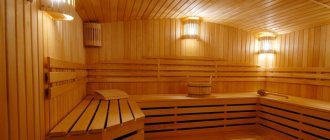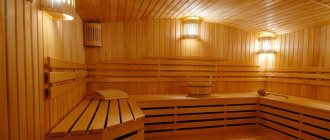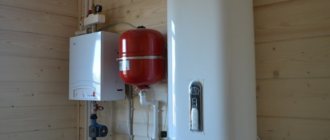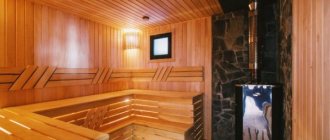Infrared emitter for sauna
Hello, dear readers! Today we’ll talk about “fashionable and useful things”...
Nowadays, modern technologies are developing at such a speed that it is not always possible to keep up with them. Our bath theme is no exception here. New promising building materials are appearing, construction methods are being updated, and even new bathhouses are being invented. A simple example is an infrared sauna.
It has neither a stove nor a heater. Here, infrared emitters, which come in different types and purposes, serve as a heat source. And this unique invention truly deserves attention. We’ll talk about what types of infrared ray emitters there are below...
Advantages of infrared devices
Among the advantages of infrared sauna heaters are:
- The compactness and attractiveness of such devices allows them to be installed even in small rooms, for example, in mini-saunas of ordinary apartments.
- Convenience and ease of installation, that is, you can do all the work yourself.
- Autonomous operation - you do not need to constantly monitor the operation of the device or add fuel, as is the case with a wood-burning stove.
- Economical - not only do heaters for infrared saunas cost much less than building a stove, but they also consume energy sparingly - 80% less than a stove.
- The speed of warming up the room is that such a heater for a sauna can bring the air in the room to the desired temperature in 20 minutes, and not in 2 hours, like, say, a stove. In addition, the air in the room remains fresh, because the device does not burn oxygen.
- The cold surface of the device body allows it to be mounted on any surface in the steam room - walls, ceiling, regardless of the material used.
However, one cannot fail to mention some of the disadvantages of such devices. In particular, it is worth considering how many people the bathhouse is designed for, since heating large rooms will require a fairly large amount of money.
When choosing the type of heating, you also need to remember about the overall design of the room, since ultra-modern equipment in a traditional Russian interior may look somewhat ridiculous. Well, of course, you should not purchase devices of dubious quality, otherwise they will not stand the test of time.
Types of infrared heaters
All devices with infrared radiation can be divided into three groups according to wavelength:
- shortwave;
- medium wave;
- long wave.
Equipment with short-wave radiation generates light fluxes of yellowish-red color in the range of 0.74-2.5 microns. It can heat up to 1000 °C. Therefore, such equipment is advisable only in rooms with high ceilings of 8-9 m, in particular, in workshops or production and warehouse premises. At the same time, you cannot stay under such waves for a long time.
Heaters with an average wave range of 2.5-5.6 microns are most often used to warm up a certain area of the room. Their heating element reaches a temperature of 600 °C. It is acceptable to use such heaters in rooms with ceilings 3-6 meters high. It is advisable not to stay in a room with such devices for more than 8 hours.
It is safest for humans and animals to undergo long-wave thermal treatment in the range of 5.6-1400 microns. In approximately this range – from 50 to 2000 microns – long-wave heaters emit heat. They are able to warm up objects and the human body, having a beneficial effect on the body. The device element heats up to 300 °C. And it can be installed in rooms with a ceiling height of up to 3 m.
Emitter design features
With all the diversity of these elements, they can be divided into several main types and classes. For ease of perception of information, we will display it in the form of a table:
| Emitter type name | Time to reach nominal temperature, min | Maximum temperature on the surface of the element, degrees Celsius | Radiation range, µm | Radiation power, W/kV.m | Emission factor,% | Reflection coefficient, % |
| Metal | 15-20 | 720-800 | 2,7-3 | 130 | 60 | 80 |
| Ceramic | 10-12 | 350-420 | 4,5-5 | 90 | 90 | 90 |
| Incoloic | 10-15 | 180-320 | 6,1-7,0 | 100 | 98 | 99 |
| Based on quartz glass element | 3 | 500-1650 | 1,4-3,7 | 110 | 90 | 95 |
| Shield | 10-12 | 60-80 | 8,1-8,7 | 80-90 | 95 | — |
| Film | 25 | 90-120 | 7,3-8,2 | 80-90 | 80 | — |
Elements based on a metal wave generator
The very first design that was used by production workers in working samples. At the moment, they are both physically and morally outdated. Design features include:
- The body is made of heat-resistant stainless steel.
- A high degree of heating of the element, sometimes to threshold values at which the emitted wavelength range passes into the visible spectrum.
- Long time to reach nominal operating temperature.
- A high degree of convection, due to which a slight increase in the air temperature in the cabin is possible.
- Low efficiency.
- Chrome reflective elements do not have the highest reflectivity.
Ceramic-based elements
They belong to the second generation, as a result of which, to some extent, they have overcome the shortcomings of the first. Due to the use of oxidized polished aluminum, the degree of reflection of the reflectors is increased to 90%. The output to operating mode is reduced by almost 50%. The overwhelming majority of emitted waves are in the invisible spectrum. Such emitters have a higher inertia, as a result of which the process of heating and regulating the intensity of the heat flow is more smooth and predictable.
Incoloic elements
Their body is made on the basis of a high-alloy alloy of iron, chromium and nickel. It has a high temperature threshold for the formation of oxides, which has a beneficial effect on the service life of the product, relative to the same elements of the first generation. The deflector is made in the form of complex surfaces, with a high reflection area, based on polished aluminum alloy. The emission and inertia coefficient is very high, which makes it possible to obtain the main emission spectrum in the infrared range and a leveled temperature curve. The U-shaped shape of the emitter allows you to get sufficient power with very modest dimensions. The time to reach the nominal operating mode remained at the level of second-generation samples.
Shield emitters
They have the lowest surface temperature. Wave radiation lies in the so-called “far” infrared range, which is as close as possible to the natural thermal background of the human body. Manufacturers promise that these products have the most significant therapeutic effect in the entire line, which includes infrared sauna heaters.
Film emitters
Based on the totality of thermal characteristics, they should be classified as the most ineffective. The time it takes for a cabin equipped with such elements to reach operating mode is about 25 minutes, and in conditions of a substandard, “drained” electrical network, even more. The undoubted advantages include very low weight, with a large radiated surface, and ease of installation, due to the extreme flexibility and plasticity of the element itself.
What does an IR sauna heater look like and work?
Externally, such a heater looks like a rectangular metal case with an infrared sauna lamp inserted into it, somewhat reminiscent of a fluorescent lamp. Inside the case there is a screen that reflects heat waves, a heat-insulating layer to prevent the case from heating up, a reflector that emits heat, and a panel with a heating element.
As soon as the device is connected to the network, the heating elements begin to heat up, transferring heat to the aluminum reflector, which emits waves. In this case, objects located in the radiation zone are heated, which in turn release heat into the air. This way the room warms up evenly.
Heating components are of the following types:
- Ceramic elements are a ceramic plate with a high-resistance conductor built into it. It is made from nichrome, which can heat up to 1000 °C, or fechral, which, having high electrical resistance, heats up to 800 °C. Typically, the service life of such a heater is 4 years.
- Tubular heaters with aluminum profile insulation. This design allows heat to be radiated along the entire length of the plate. Often, several such heating elements are installed simultaneously in IR heaters. The service life of the equipment is about 7 years.
- The carbon heating element is a quartz tube with a built-in carbon spiral filament. The flask is completely sealed and devoid of air. Carbon fiber can heat up to 3000 °C without losing strength. Therefore, such equipment can be used for a very long time if it is well made.
The reflector plate, depending on the type of element, can heat up to 250-600 °C, but the body itself does not become hotter than 60 °C.
The overall dimensions of such a device are 16 cm wide, 4 cm thick, 1-1.5 m long and 3.5-5 kg weight.
Typically, the kit for an infrared sauna includes the heater itself, as well as fastening elements - hardware, brackets, dowels and screws. But the thermostat, cable with plug, cross-section designed for the expected load, automatic power switches and other components must be purchased additionally.
If everything is connected correctly, the equipment can last about 25 years.
Reflectors
An infrared emitter made of ceramics for a sauna in St. Petersburg and other regions can replace a reflector. It is a curved metal plate with a reflector. This solution makes it possible to accumulate more than 90% of the emitted energy at the facility. Modifications of reflective elements correspond to the parameters of ceramic analogs of the ECS-2, FCH-2 types.
The wide reflector configuration allows the radiation to be softened and dispersed at an angle of approximately 120 degrees. Similar variations are used in small booths where a person sits in close proximity to the device. Corner analogues concentrate beams in a range of 90 degrees and are mounted in spacious saunas, concentrating heat on the bench.
Principles for choosing an IR heater for a bath
When selecting equipment for a sauna, you should pay attention to such parameters as:
- dimensions;
- wavelength and power;
- company manufacturer;
- body coating;
- type of installation.
Manufacturers of infrared equipment
Perhaps the highest quality IR devices are produced in Russia. Among the most famous representatives producing reliable and durable products are “Peony”, “Ecoline”, “Master Hit”, “Ballu”. Their range allows you to choose a suitable device with any parameters.
Italian products are represented by the brands “ITM” and AEG.” All of their heaters are equipped with moisture-resistant housings that are not subject to mechanical wear.
German companies, Eckerle and Kroll, produce heaters with economical energy consumption. At the same time, such equipment is distinguished by high power and excellent quality.
Also on the market are IR heaters from French companies. In particular, it presented models that, despite their small size, are quite capable of replacing the main heating source. Another brand, Noirot, is distinguished by its high heating speed, compact size and safety.
In addition, you can purchase an infrared sauna emitter made in Switzerland, which is reliable in operation and attractive in appearance, as well as products from companies from Turkey, Denmark, Greece or Sweden.
Thanks to such a wide range, you are guaranteed to be able to find the most suitable sauna equipment for yourself.
Principle of operation
Infrared emitters for saunas (photo above) resemble a fluorescent lamp in structure and are made in the form of rectangles. The sheet metal body is coated with a special powder coating. Inside there is a heating panel with a carbon, ceramic or tubular working element. A reflector is provided on top of the heat reflector, which serves to release heat. The inside of the case is protected by a heat-insulating gasket that prevents heating of the surface of the device.
Plugging the device into the network activates the heater's action on the aluminum plate, which begins to emit waves. Energy is transferred with heat evenly, accumulating the bulk of the mass in the area of the floor, not the ceiling.
Methods for installing IR heaters
Floor-mounted IR heaters have the simplest and most convenient installation. However, they take up a lot of space and can be accidentally knocked over by children, for example. Therefore, units of this type must have an automatic shutdown function if they fall.
Wall-mounted infrared heaters are somewhat more difficult to attach, however, this disadvantage is compensated by their compactness, safety and organic appearance.
The most difficult thing is to install ceiling structures that can evenly distribute heat waves throughout the room.
Very often they buy an infrared stove for a sauna, which can be built into the corner of the steam room. As a rule, such devices can open 90° or 120°.
The temperature in the steam room can be maintained at a certain level for a long time by installing a thermostat with a rotary mechanism, preferable for use in saunas.
Equipment requirements upon purchase
When purchasing an IR heater, you should check the following points:
- integrity of the packaging, presence of protective linings on the case;
- checking the device for operability - the seller has no right to refuse;
- silent operation of the unit - if there are extraneous sounds, then it is better not to buy this device;
- provision of a warranty card and purchase receipt;
- the seller has quality certificates for the goods.
If one or more of the listed conditions are not met, you should refuse to purchase the product in this store.
We get it right
So that after purchasing this device you do not end up with bitter disappointment and regret about wasted funds, when purchasing you should pay attention to the following things:
- The packaging must not be damaged; in some cases, the case is protected with foam inserts;
- Before purchasing an infrared heater, it is imperative to check the device; the dealer’s assurances that everything works and no one has complained yet are not an excuse to cancel testing the equipment;
- The device should operate quite very quietly. Based on this, the inspection is carried out directly on the sales floor. Any sound created by a device is an excuse to avoid purchasing it;
- The purchase of an electric mechanism is accompanied by the following documents: a receipt and a completed warranty card;
- Request a certificate for this device, study it - all data on the model you receive must match.
The absence (failure to provide) of the first of the above documents serves as a basis for refusal of acquisition.
Recommendations for using IR heaters
To make using IR heaters as pleasant as possible, you should pay attention to some recommendations:
- It is better to install the equipment vertically, because people mostly sit in the sauna. In this case, several devices must create a single heat flow, that is, they need to be placed on the back wall, on the sides, above the door and in the riser of the bed.
- The larger the room, the higher the power of the device is needed, since it must heat all surfaces, objects and people in the room.
- The efficiency of the equipment is determined by the emissivity coefficient, that is, at a value of 80%, only 20% of the energy will be lost.
- The power of the device is also affected by the height of the ceiling, since weak devices will not be able to generate waves of such strength that they can reach the floor in a room with a high ceiling.
- The opposite situation will be observed if a heavy-duty device is installed in a low sauna, since it will be uncomfortable to be in it due to excessive radiation.
Control system
- Infrared radiation has different effects on human skin, and the body reacts differently to the rays. Control systems, which are available in 2 types, are responsible for a comfortable stay in the sauna.
- The lightest, but ineffective, system with temperature control . The operating mechanism consists of turning off the heating parts when this parameter is reached. In this case, the emitters will stop generating energy. At a time when the temperature reaches a low value, the thermoelement reconnects the heating modules. Thus, the devices operate repetitively, and the human body does not warm up completely.
- The system with power regulation has good performance . By setting the appropriate power, the microprocessor keeps the beam flow under control. In this case, the IR heaters do not turn off, but smoothly change the level of supplied energy. The regulator allows you to select a mode to suit a person’s personal characteristics. As follows, the deepest and most uniform heating is ensured for children, people with sensitive skin, and those who like to take a deep steam bath. Such a system consists of separate parts:
- The control panel is installed on the outside of the cabin. The digital display indicates the procedure time and radiation power. The system can be configured for a certain period of time, after which the heaters are mechanically disconnected from the network. The remote control allows you to control 2 power control units.
- The power control unit is recommended for controlling the operation of heaters. A device with a power of up to 1.1 kW is used in standard cabins with a capacity of 1-2 people and can control the operation of up to 6 heaters. The heater, whose power produces 1.5 kW, is suitable for multi-person saunas and can control the operation of up to 8 heating devices.
- The internal control panel is used to adjust the required characteristics to ensure a good experience in the sauna cabin.
The system can also be equipped with additional functions, for example, “smooth heating”, which allows you to avoid jumps in starting currents, or a “time counter” mode, where the system turns off heating devices after a certain time; this is relevant if the sauna is intended for commercial purposes.
IR heaters are supposedly designed for sauna equipment, which is subject to the highest safety requirements. Their silent operation, fast and uniform heating of the room and the human body are what you need for a relaxing holiday. A long service life and low electricity consumption make this device perfect in terms of price-quality ratio.
Film-type infrared heaters
To equip an additional heating source, it is advisable to use infrared film. A 1 micron layer of carbon paste is applied to it and carbon fibers are glued on. The film insulation is made of polyester, permitted by electrical insulation and fire safety standards. The emission range of the film is 5-20 microns, and the heating intensity is from 30° to 110°.
This film can be laid under absolutely any coating, including ceramics or stone. Although in the latter case, installation must be carried out by specialists.
Thanks to decorative lamination, infrared film can be mounted on the ceiling or walls.
The package with thermal film includes a thermostat and a cable with a plug. The service life of such devices can be more than 20 years if the product is of really high quality and is used from time to time.
Flat IR devices
As a rule, infrared panels are intended for intensive use, so they are mounted under the bed, above the entrance, on the side and rear walls of the steam room.
The IR heating panel with a mirror coating looks especially beautiful. It is very convenient, because it also performs the main function - heating, and is a mirror that gives the room visual depth. And neon lighting will make the interior almost cosmic.
Panels
Flat emitters are used for rear walls. They cut into the sides of the canopy or are mounted into the lower part of the bench. The panels are distinguished by their work intensity at a maximum operating temperature of 70 degrees.
The decorative frame of flat heaters is usually made in “silver” or “gold”, which allows you to choose a model for different interiors. There are examples with a mirror surface. These options combine a mirror and a heater. Additionally, the device can be equipped with LED backlighting.











